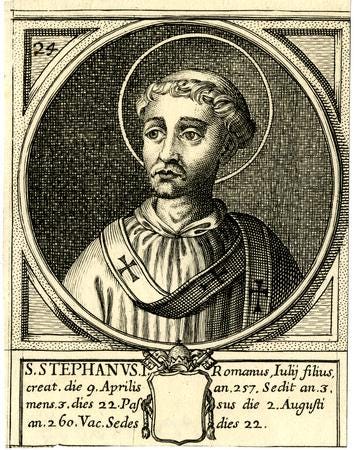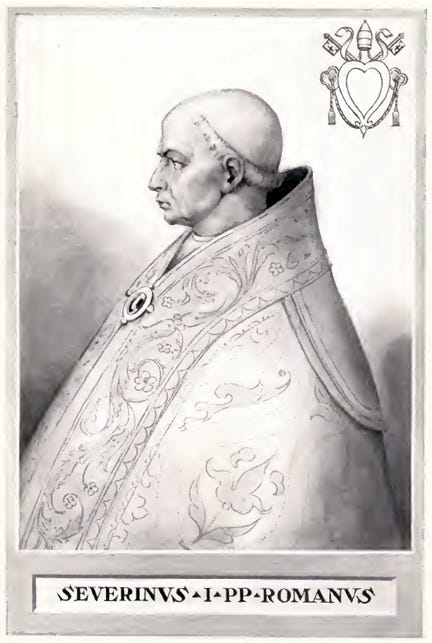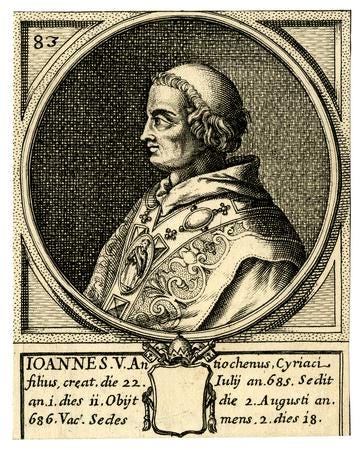The day that three popes died
One was a saint, two reigned in the same century, and all three...were pretty decent guys who died too soon.
Today in Papal History – August 2 – marks the date that three of the 264 men to sit in the Chair of St. Peter went on to their eternal reward.
These are the popes:
Pope St. Stephen I (d. 257 AD)
Pope Severinus (d. 640 AD)
Pope John V (d. 686 AD)
(Technically Pope Cyril VI of Alexandria also died today – in 1902 – but he was the Coptic Orthodox Patriarch. Same title, different job.)
257 A.D.
Pope St. Stephen I was the first among these three fine fellows to give up the ghost on the Second of August, having done so after reigning over the still-illegal Catholic Church for just over three years.
Born in Rome but coming from Greek ancestry, he became the 22nd Successor of St. Peter in May of 254, at a time when the Roman persecution of Christians had relented for the moment.
Stephen was best known for how he handled the interesting conundrum of how to handle the lapsi – those Christians who had renounced their faith and sacrificed to pagan idols in order to avoid death, and then afterward wished to come back into full communion with the Church once again.
While there were some who were content with a “one and done” attitude, all but saying good riddance to those who caved under pressure (or at the very least demanded that such people be re-baptized), Stephen I was not one of them. He was renowned for being merciful even to clergy who had broken away, and clarified that one baptism was plenty.
Pope Stephen I – though he likely was not himself martyred – still nevertheless is now honored as a saint in the Catholic and Eastern Orthodox Churches, and his feast day is celebrated today also.
640 A.D.
Pope Severinus, the 71st pontiff in history, was elected in October of 638 A.D. to follow Pope Honorius I, but strangely enough wouldn’t officially be installed for over 18 months while a spat with Emperor Heraclius, leader of the Eastern Roman Empire.
To keep a very long story very short, the topic at issue was the heresy known as Monothelitism, the belief that Jesus Christ had only one will (as opposed to two wills – divine and human).
Heraclius ascribed to this belief (and wasn’t much a fan of the Pope of Rome), and as such drew up a decree making Monothelitism the official “brand” of Christianity throughout the empire. The Patriarch of Constantinople, Sergius – who was little more than a mouthpiece for the emperor – had tried in vain to hoodwink Honorius I into approving the movement, so the two of them sought to block Severinus’ accession to the Chair of Peter until he signed and approved the decree.
At any rate, Pope Severinus categorically refused to sign the document, known as the Ecthesis, and he paid dearly for it. The emperor’s representative, the Exarch of Ravenna, ginned up a mob and arranged for the plundering of the Lateran Palace, eventually looting it himself for over a week.
But Severinus remained unmoved.
With the emperor now himself dying by that point, a compromise was able to be reached at the end of May in 640 A.D., finally allowing Severinus to officially be installed as pope without signing a heretical decree.
Sadly, however, the hits didn’t stop. The pope, who was described in an ancient history of the papacy as “a kind, generous and mild holy man, a benefactor to the clergy, and a friend to the poor”, barely lasted two months in office before dying on August 2, 640.
686 A.D.
Pope John V, the last of the three men to have died Today in Papal History, has himself an equally compelling story as his two confreres above.
He hailed from the East, having been born in Antioch (modern-day Turkey), was the first in a line of ten consecutive Eastern-born popes, and happened to also fall in line of unusually short papal reigns – he was the ninth of the prior 12 pontiffs to reign less than 5 years, and four out of the five popes who followed John V were in the same boat.
In any event, Pope John V was elected during a period known as the Byzantine Papacy, a period of just over 200 years that spanned the mid-6th Century to the mid-8th Century where new popes were more or less required to obtain imperial approval from far-off Constantinople before being allowed to officially take office.
Lucky for John V, he was elected pope just a year or two after Emperor Constantine IV had lifted that requirement, thus allowing him to be crowned immediately.
But sadly, this pope wasn’t long for this world. After taking office on July 23, 685, he lasted only a year and 10 days before dying.
Pope John V was buried in Old St. Peter’s Basilica with an inscription that read:
“With the titles of the faith, keeping such vigilance, you united the minds so that the inimical wolf mixing in might not seize the sheep, or the more powerful crush those below.”
And so there you have it: three popes who all died on the same day. I’m not yet sure such a thing has happened on another date…but at least you’re in the right place to find out if it did.






